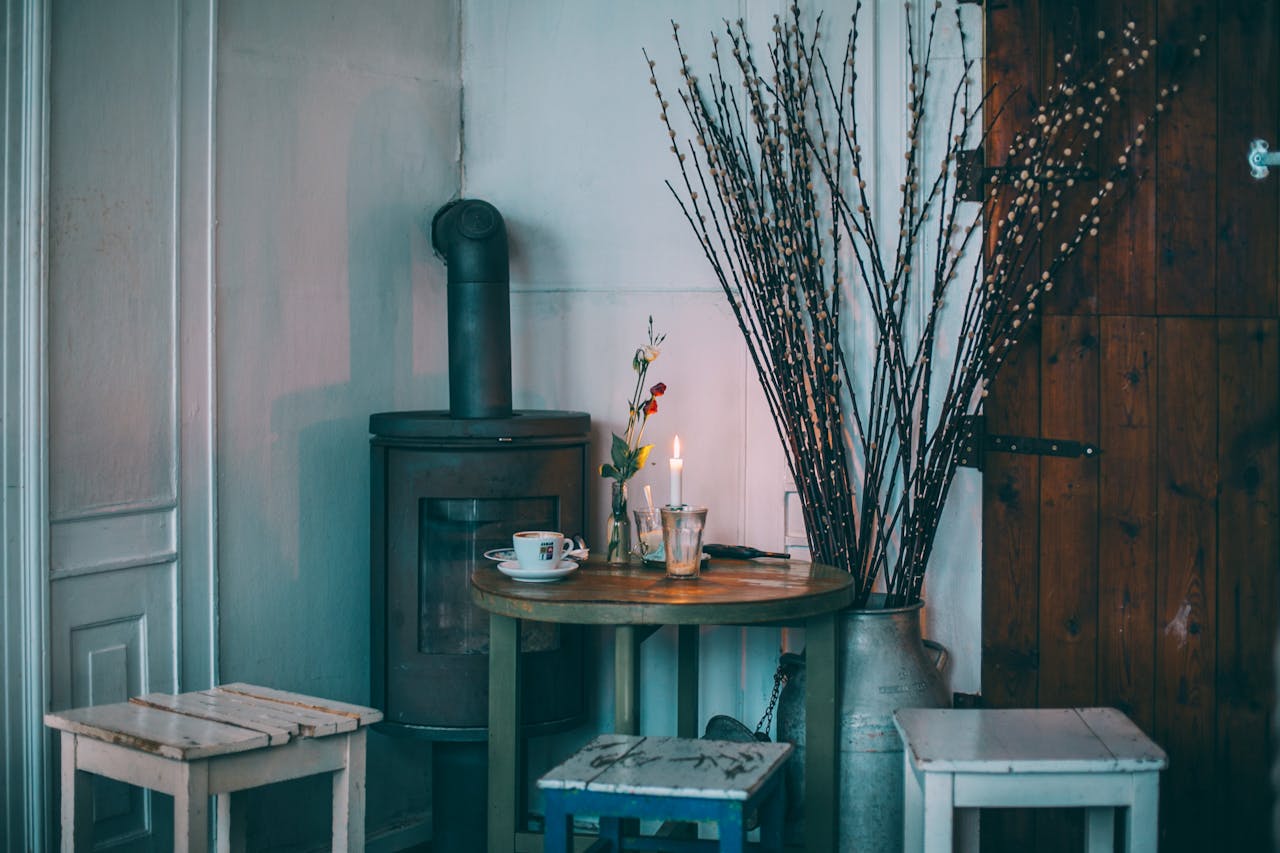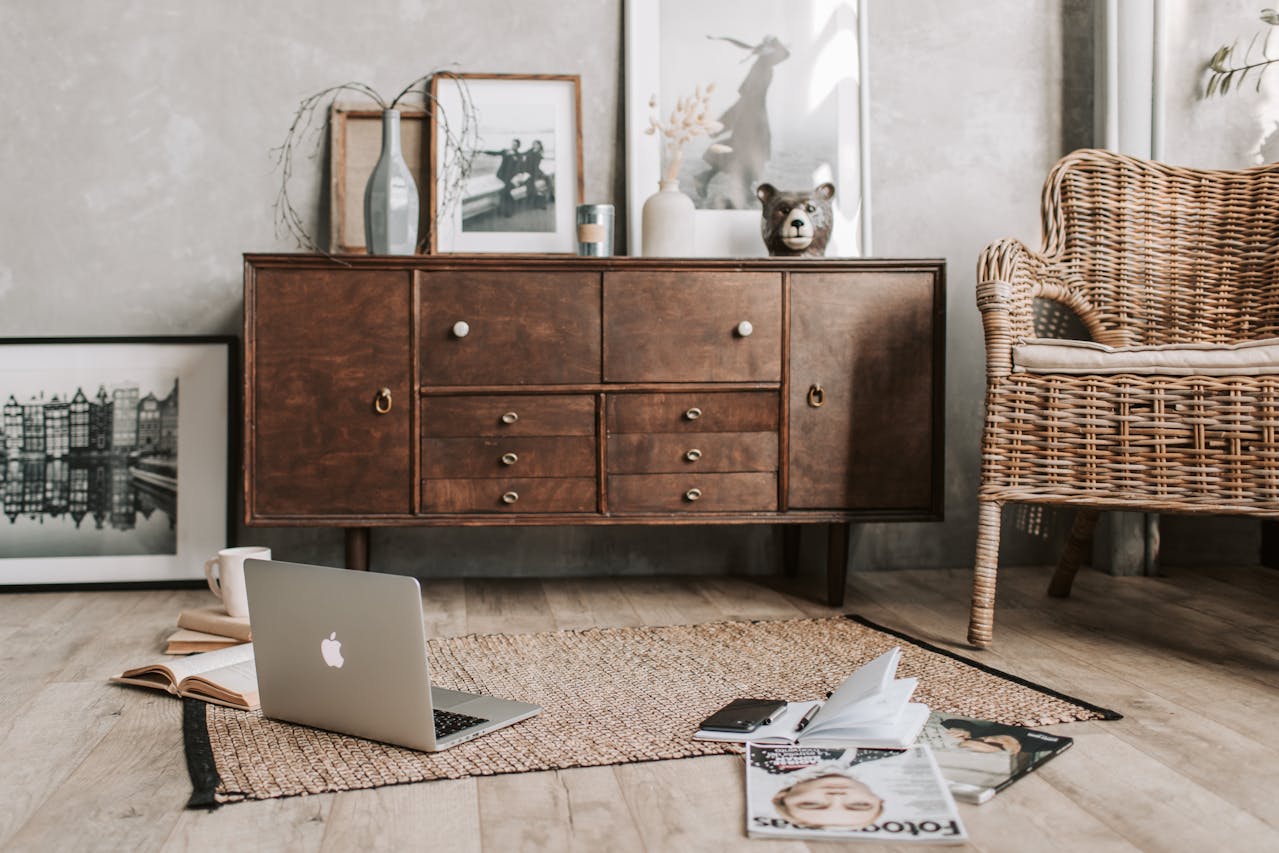Rustic interior design is a celebration of the beauty found in the natural world and the warmth of a home that embraces it. It is a style that brings the serenity and richness of the outdoors inside, creating both comforting and inviting spaces.
The rustic design focuses on the raw and unrefined, highlighting materials such as wood, stone, and metal in their most natural forms. This design philosophy is not just about aesthetics; it’s about crafting environments that reflect a love for simplicity and authenticity.
As we delve into rustic interior design, we explore how this timeless style can transform any space into a cozy haven, rich with textures and imbued with a sense of history and charm.
The Origins of Rustic Design
The origins of rustic design can be traced back to the great outdoors and rural life’s simple, unspoiled beauty. Historically, it emerged from necessity, with homes built using materials readily available in the natural environment. This approach resulted in living spaces inherently connected to the surrounding landscape, embodying a sense of place and purpose.
Over time, as societies evolved and moved towards more urban lifestyles, the rustic aesthetic was romanticized and sought after for its connection to the natural world and its more straightforward times. Today, rustic design has been adapted to fit contemporary settings, blending the traditional with the modern to create spaces that are both functional and evocative of the past. This evolution reflects a growing desire to reconnect with nature and embrace a more authentic, grounded way of living.
Key Characteristics of Rustic Interior Design
Rustic interior design is defined by several key characteristics that distinguish it from other design styles. At its heart is natural materials such as wood, stone, metal, and leather, chosen for their unrefined beauty and texture.
The color palette in rustic interiors leans heavily towards earthy and neutral tones, mirroring the hues found in nature, from deep browns and grays to warm beiges and greens. Furniture pieces are robust and handcrafted, often with a visible history or patina that adds depth and character to the space.
Textures play a crucial role, with a preference for raw and tactile materials contributing to an overall sense of warmth and comfort. Lighting in rustic design is soft and inviting, utilizing natural light where possible, complemented by fixtures made from raw materials or in vintage styles. This combination of elements creates an atmosphere that is grounded and inviting, offering a retreat from the fast pace of modern life.
Rustic Design Elements
The elements of rustic design are deeply rooted in a connection to the natural world, using architectural features and decorative touches that enhance the sense of warmth and authenticity.
Exposed wood beams, stone fireplaces, and sliding barn doors are common architectural elements that add rustic charm to a space. The roughened textures, including driftwood lighting fixtures, butcher block countertops, animal hide throws, sisal, or jute, would be ideal for rustic home decor.
Decorative touches such as antiques, heirlooms, and handmade objects are integral, telling stories of the past and adding layers of interest. Using fabrics made from natural fibers like wool, burlap, and linen adds texture and reinforces the connection to nature. These elements are carefully combined to create a space that feels both timeless and lived-in.
Whether through the architectural foundation of a room or the decorative accents that fill it, rustic design elements work together to create an environment that celebrates simplicity, craftsmanship, and the beauty of the natural world.
Rustic Design in Different Rooms
Rustic fabrics and furniture have a rough aspect, and the design might appear a bit rugged. The design might appear unfinished despite the furniture or materials being made from stone or raw wood, although that’s the final product.
Incorporating rustic design across different rooms in a home allows for a cohesive yet unique expression of this timeless style in each space. Each room can embrace rustic elements in ways that enhance functionality and aesthetic appeal:
Kitchen:
- The heart of a rustic home, kitchens can feature open shelving made from reclaimed wood, farmhouse sinks that add a touch of country charm, and cabinets with a distressed finish. Essential elements include:
- Butcher block countertops
- Classic, antique, or industrial-inspired lighting fixtures
- A mix of open and closed storage to display cherished items and hide the rest
Living Room:
- A rustic living room invites relaxation and conversation, with plush leather sofas, large wooden coffee tables for a communal feel, and layered rugs that add warmth and texture. Key features are:
- A stone fireplace as the focal point
- Natural wood accents in furniture and décor
- Warm, ambient lighting to enhance the cozy atmosphere
Bedroom:
- A sanctuary that embodies rustic comfort, featuring beds with reclaimed wood headboards, quilted throws, and wrought iron light fixtures. To achieve a rustic bedroom, consider:
- Soft, natural fiber linens
- Rustic or vintage dressers and nightstands
- Warm, muted color schemes that invite rest
Bathroom:
- Transform bathrooms into rustic retreats with stone basins, wooden vanities, and clawfoot tubs. Elements to incorporate include:
- Natural stone tiles or wooden floors
- Antique mirrors and fixtures
- Freestanding tubs with vintage faucets
Each room’s design can be tailored to suit personal tastes while still adhering to the rustic theme, creating spaces that are visually cohesive, deeply personal, and inviting.
Tips for Achieving a Rustic Look
Achieving a rustic look in your home involves more than selecting the right furniture and accessories; it’s about capturing the essence of natural simplicity and warmth. Here are some tips to guide you:
- Embrace Natural Materials: Incorporate materials like wood, stone, and metal in their most natural forms to bring the outdoors inside.
- Mix and Match: Combine old and new elements to create a space that feels both timeless and lived in. Vintage finds, and modern pieces can coexist harmoniously when chosen carefully.
- Focus on Textures: Layer different textures through rugs, throws, and cushions to add depth and interest to rooms. The tactile quality of these elements can enhance the cozy feel of a rustic space.
- Opt for Earthy Tones: Stick to a color palette inspired by nature, with earthy and neutral tones that evoke a sense of calm and groundedness.
- Lighting is Key: Choose warm, ambient lighting. Soft, diffused light fixtures from natural materials or in antique styles can complement the rustic aesthetic.
- Add Personal Touches: Decorate with items that have a story to tell, like family heirlooms, handmade crafts, or finds from nature walks. These personal touches add character and authenticity to the rustic decor.
Common Mistakes to Avoid
While creating a rustic-inspired space, there are several common pitfalls to be wary of:
- Overcrowding: Rustic design values simplicity and openness. Avoid cluttering spaces with too much furniture or decor, which can detract from the overall aesthetic.
- Over-Mixing Materials: While a hallmark of rustic design is the use of natural materials, using too many different types in one space can create a disjointed look. Aim for a harmonious blend that feels cohesive.
- Neglecting Comfort: The rustic style is as much about comfort as it is about looks. Don’t sacrifice comfort for style; choose pieces that invite relaxation and make the space feel welcoming.
- Ignoring Scale: Pay attention to the scale of furniture and decor. Oversized pieces in a small room can overwhelm the space, while too many small items can make a large room feel cluttered.
- Too Theme-Centric: Avoid making the space feel like a theme park by incorporating rustic elements subtly. It’s about capturing the essence of rustic charm, not creating a caricature.
- Forgetting Modern Amenities: Integrating rustic design doesn’t mean you have to live without modern conveniences. It’s possible to blend rustic aesthetics with contemporary functionality seamlessly.
Avoiding these mistakes can help maintain the balance and authenticity of your rustic interior design, ensuring it remains true to its roots while being practical and comfortable for modern living.
Conclusion
You don’t have to live in a log cabin for your home to be rustic. There are distinct elements that make a home rough; thus, you should consider implementing rustic designs in your home. As earlier stated, you can apply the rustic interior design in different rooms at home. The above are all the facts that you need to know about rustic design. Therefore, implement the rustic design in your space.


